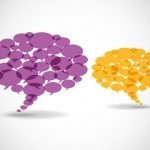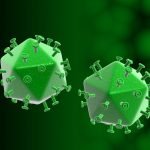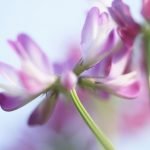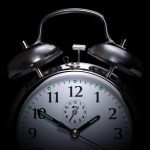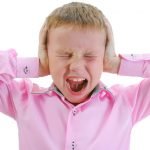The Spirit That Resides in the Heart
Robin DiPasquale, ND, RH(AHG)
Heart 7, Shen Men
神門
“Spirit Gate”
In Taoism, shen men refers to the eyes, which reflect the presence and strength of the Spirit, the place where the Spirit enters and exits.1(pX)
When a patient tells the physician that he or she is experiencing insomnia, the first prescription usually given is a sleeping pill. Whether pharmaceutical or herbal, this sleeping pill will generally have sedative or hypnotic actions. While these actions will often help the nervous system to become quiet and calm, which can potentially get the patient to sleep, these medications do not always bring about a more deep restful sleep with a refreshed and renewed feeling on waking, especially over the long term. This type of treatment is not necessarily getting to the cause of the insomnia.
With patients who report insomnia, it may become necessary to look a bit deeper and, in doing so, to evaluate the state of the patient’s shen. Shen is often referred to as the spirit and, in some Traditional Chinese Medicine (TCM) references, the spirit that resides in the heart. It is the heart-mind. It is that which is responsible for the consciousness. It is the consciousness. The heart regulates blood circulation, but the heart also regulates the spirit, sleep, and memory and houses the mind. Ted Kaptchuk writes, “Shen is the awareness that shines out of our eyes when we are truly awake.”2(pX) In a healthy person, shen is the capacity of the mind to form ideas and the desire of the personality to live life.
Jing, qi, and shen are the 3 treasures. Jing is the source of life, the essence. Congenital jing is inherited. Acquired jing comes from nutrients taken in daily. Together, they are the substance that underlies all organ life. Qi is the ability to activate and move, the source of all movement. Qi protects the body, warms the body, governs the retention of body substances, and is the source of all harmonious transformations.
Jing and qi are mutually dependent. Qi emerges out of jing; congenital jing is the root of life, and qi helps transform food into acquired jing, maintaining and expanding life.
Shen is the vitality between jing and qi. it is the essence and the movement of the essence.2,3
Shen is nourished by qi and blood. Shen is related to the heart. The heart’s function is to rule blood and shen. Disharmonies of qi and blood give rise to the “changes of the hundred diseases,” among them shen disturbance, that of wandering in the mind, imbalances in the heart, and an unstable spirit. Symptoms of shen disturbance, of an unstable spirit, can include insomnia, interrupted sleep, memory loss or forgetfulness, irregular or racing heartbeat, excessive dreaming, a feeling of “dis-ease” or unease, and irrational behavior.2
With insomnia, when the heart function is involved, there are 2 TCM patterns to be differentiated. These are deficient heart blood and deficient heart yin.
When there is difficulty falling asleep but ability to stay asleep once there, this can be an indication of deficient heart blood. It is associated with deficient spleen qi (the spleen produces blood) and manifests as a pale tongue, pale face, pale nail beds, and thin and sluggish pulses, with dizziness and lethargy. The patient demonstrates an overall deficient state and is fatigued, often with compromised digestive function.
When falling asleep is not a problem but there is recurrent waking during the night, this can be an indication of deficient heart yin. It is associated with deficient kidney yin (the kidneys are a source of yin to the organs) and manifests as a reddish tongue and cheeks, with rapid and thin pulses. There is excess heat (often the cause of waking) expressing as night sweats and warm palms of hands and soles of feet, with an agitated and nervous manner.
Cardiovascular symptoms are seen with both patterns, deficient heart blood and deficient heart yin. These include tachycardia, arrhythmias, hypertension, and hyperthyroidism.2
Heart tonic herbs and gemmotherapy remedies can be an effective part of a treatment protocol, including Crataegus oxycantha (hawthorne), Terminalia arjuna (arjuna), Selenicereus grandiflorus (night-blooming cereus), Tilia species (linden), Leonurus cardiaca (motherwort), and Viscum album (mistletoe). Moving blood will eliminate blood stagnation, bringing more blood flow to deficient areas, including the heart. Blood-moving herbs can include Capsicum annuum (cayenne), Zanthoxylum americanum (prickly ash), Ginkgo biloba (ginkgo), Rosmarinus officinalis (rosemary), Zingiber officinale (ginger), Armoracia rusticana (horseradish), and the gemmotherapy remedies Alnus glutinosa (European alder) and Cornus sanguinea (dogwood). Tonifying and nourishing yin and blood are 2 goals to work toward when balancing these patterns. Herbs to tonify yin and blood are discussed in detail in the February 2011 issue of NDNR. In working with hyperthyroidism, remember the four Ls of hyperthyroid herbal treatment, namely, Leonurus (motherwort), Lycopus (bugleweed), Lithospermum (gromwell), and lemon balm (Melissa officinalis).
Using TCM herbal medicine, the following 3 formulas can be considered to address insomnia with shen disturbance: (1) If heart blood deficiency is present (falling asleep is a problem but then stays asleep), the formula called Calm the Shen can tonify heart blood, heart qi, spleen blood, and spleen qi and stimulate the spleen’s holding of blood.4 The inclusion of Polygala root speaks strongly about the action of this formula. It is said that the ancient name for this herb is the will strengthener. The herb is believed to have the ability to strengthen that part of the psyche that we call the will. (2) If heart yin deficiency is present (able to fall asleep but then wakes often during the night and is unable to go back to sleep), the formula Root the Spirit can nourish liver blood and liver yin, calm the mind, and promote sleep.4 (3) A formula that calms the spirit, nourishes blood and heart yin, and moistens the intestines is Calm Spirit.5 It is used to alleviate stress-associated emotions and to relieve insomnia. The detailed formulas are given in Table 1.
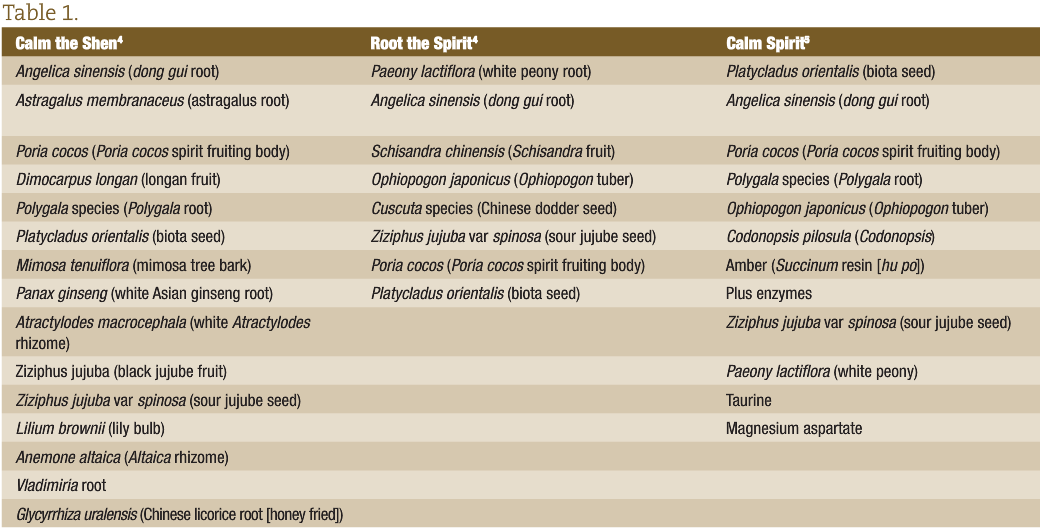
When treating insomnia related to shen disturbance, better outcomes can result from keeping in focus what the emotional state of the patient is and how he or she expresses the imbalance individually. The primary emotions of the heart, spirit, and shen are sadness and joy, which are opposite polarities of the same emotion. Other emotions expressed with shen disturbance develop through energetic imbalances in other organs. Grief depletes the heart and lungs. Worry knots qi of the lungs, heart, and spleen. Fear can show up as a sudden fright, where kidney qi descends, or as a chronic state of anxiety, where the heart is weak and kidney yin is deficient. Guilt is found under “anxiety of conscience” in the homeopathic repertory. In TCM, it is called “xin li you gui,” which means an evil spirit harbored in the heart, and guilt affects the heart and kidneys. Anger is often related to rising liver qi or excess liver heat.6 Insomnia can often be a result of the emotional body, which is not allowing the physical body to rest.
The flower essences can be an invaluable tool to reach the emotional level in shen disturbance, helping bring the emotions back to a more balanced state and allowing the physical level to follow. Table 2 lists short differentials for each of the emotions listed.7-11 The flower essences can be added directly to any herbal formula or gemmotherapy remedy or may be given on their own.
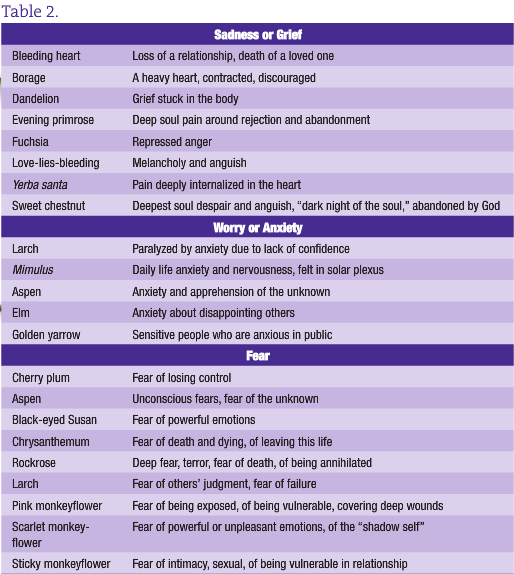 The essential oils (EOs) can be another valuable clinical tool when working with persons expressing insomnia and shen disturbance. Because the EOs have direct access to the brain via the olfactory nerve, inhalation of the oils brings rapid and direct influence. Certainly, there are t
The essential oils (EOs) can be another valuable clinical tool when working with persons expressing insomnia and shen disturbance. Because the EOs have direct access to the brain via the olfactory nerve, inhalation of the oils brings rapid and direct influence. Certainly, there are t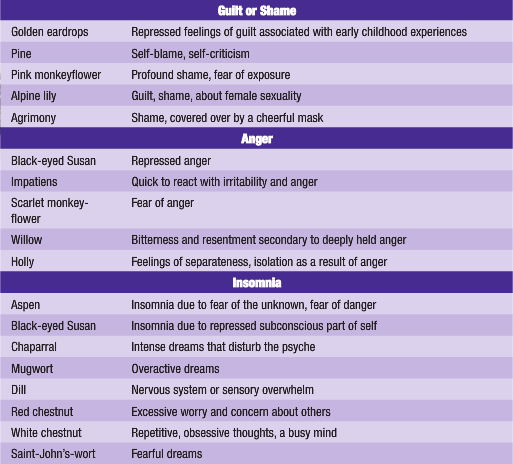 he more soothing, quieting, and calming EOs, including Lavandula angustifolia (lavender), Anthemis nobilis (Roman chamomile), and M officinalis (lemon balm). Grounding EOs can also be applied to quiet the chatter of the mind, including Santalum species (sandalwood), Cedrus atlantica (cedar), Pogostemon cablin (patchouli), and Vetiveria zizanoides (vetiver).12
he more soothing, quieting, and calming EOs, including Lavandula angustifolia (lavender), Anthemis nobilis (Roman chamomile), and M officinalis (lemon balm). Grounding EOs can also be applied to quiet the chatter of the mind, including Santalum species (sandalwood), Cedrus atlantica (cedar), Pogostemon cablin (patchouli), and Vetiveria zizanoides (vetiver).12
In the patterns of shen disturbance, however, EOs that have the ability to reach into the heart will be most effective. The EO most considered “of the heart” is Rosa damascena, the Damascus rose, cultivated largely in Bulgaria in the Valley of Roses. It takes 67 roses to make 1 drop of rose EO. Rose EO opens the heart, allowing shen to be full, to be bright, and to express love, but it also touches the heart with tenderness and adoration. It is the oil to be used during meditation of the heart, the loving kindness meditation. It is the oil used to enhance love and to heal from the wounds of broken love. Rose is the oil to be considered to assist in sleep when the inability to sleep is related to matters of the heart.
The floral oils work deeply on the energy of the heart as well. These include jasmine, ylang-ylang, and neroli oil.13
Whether Jasminum grandiflorum (the dawn-blooming jasmine with its softer, sweeter, ethereal scent) or Jasminum sambac (the night-blooming jasmine with its heavy, sweet, sultry scent), both of these EOs will assist in bringing forth joy and love from deep in the soul, lifting the heart spirit. They give a pause, a time to reflect and to link our consciousness with our higher self.
Cananga odorata (ylang-ylang) is the flower of flowers. It opens the heart yet shields it from harm. It allows the spirit self to show its passion, to express itself from the heart. Ylang-ylang is soothing to the nervous system, bringing a stillness to excess frenetic energy. It calms the adrenal glands, allowing kidney yin to be supported.
One of the most precious of EOs, Citrus aurantium (neroli oil), resonates one of the highest vibrations. It has solar energy, uplifting to the spirit. This EO can assist with insomnia from shen disturbance because it lifts sorrow and sadness, liberating a heavy heart.
When patients report that they are experiencing insomnia, look beyond the sedative or hypnotic sleeping pill. Whether the treatment is focused on Western herbs, TCM herbs, gemmotherapy, flower essences, EOs, or any other modality from your naturopathic toolbox, look more deeply toward the cause of insomnia. The sleep disturbance may be related to the spirit that resides in the heart.
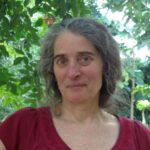 Robin DiPasquale, ND, RH (AHG) earned her degree in naturopathic med-icine from Bastyr University in 1995 where, following graduation she became a member of the didactic and clinical faculty. For the past eight years she has served at Bastyr as department chair of botanical medicine, teaching and administering to both the naturopathic program and the bachelor of science in herbal sciences program. Dr DiPasquale is a clinical associate professor in the department of biobehavioral nursing and health systems at the University of Washington in the CAM certificate program. She loves plants, is published nationally and internationally, and teaches throughout the U.S. and in Italy on plant medicine. She is an anusara-influenced yoga instructor, teaching the flow of yoga from the heart. She currently has a general naturopathic medical prac-tice in Madison, Wis., and is working with the University of Wisconsin Integrative Medicine Clinic as an ND con-sultant. [email protected]
Robin DiPasquale, ND, RH (AHG) earned her degree in naturopathic med-icine from Bastyr University in 1995 where, following graduation she became a member of the didactic and clinical faculty. For the past eight years she has served at Bastyr as department chair of botanical medicine, teaching and administering to both the naturopathic program and the bachelor of science in herbal sciences program. Dr DiPasquale is a clinical associate professor in the department of biobehavioral nursing and health systems at the University of Washington in the CAM certificate program. She loves plants, is published nationally and internationally, and teaches throughout the U.S. and in Italy on plant medicine. She is an anusara-influenced yoga instructor, teaching the flow of yoga from the heart. She currently has a general naturopathic medical prac-tice in Madison, Wis., and is working with the University of Wisconsin Integrative Medicine Clinic as an ND con-sultant. [email protected]
References
- Lade A. Acupuncture Points: Images & Functions. Seattle, WA: Eastland Press; 1989.
- Kaptchuk TJ. The Web That Has No Weaver. New York, NY: Congdon & Weed; 1983.
- Jarrett L. Nourishing Destiny: The Inner Tradition of Chinese Medicine. Stockbridge, MA: Spirit Path Press; 2004.
- Maciocia G. Classical Formulae for the Modern World: Selected Formulae From The Three Treasures and Women’s Treasure. Scotts Valley, CA: Kan Herb Co; 2003.
- Gaeddert A. Health Concerns Clinical Handbook. Oakland, CA: Professional Health Concerns; 1997.
- Maciocia G. Obstetrics & Gynecology in Chinese Medicine. New York, NY: Churchill Livingstone; 1998.
- Bach E. Heal Thyself. New Canaan, CT: Keats Publishing Inc; 1997.
- Bach E. The Twelve Healers. New Canaan, CT: Keats Publishing Inc; 1997.
- Wheeler FJ. The Bach Remedies Repertory. New Canaan, CT: Keats Publishing Inc; 1997.
- Kaminski P, Katz R. Flower Essence Repertory. Nevada City, CA: Flower Essence Society; 2004.
- Scheffer M. The Encyclopedia of Bach Flower Therapy. Rochester, VT: Healing Arts Press; 2001.
- Harrison J. Aromatherapy: Therapeutic Use of Essential Oils for Esthetics. Clifton Park, NY: Milady; 2008.
- Worwood VA. The Fragrant Heavens: The Spiritual Dimension of Fragrance and Aromatherapy. Novato, CA: New World Library; 1999.




